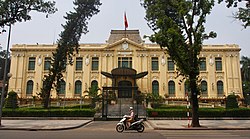State Guest House (Vietnam)
| State Guest House (Tonkin Palace) | |
|---|---|
| Native name Nhà khách Chính phủ or Bắc Bộ Phủ (Vietnamese) | |
 Tonkin Palace functions as Vietnam's State Guesthouse today | |
| Location | Hoàn Kiếm District, Hanoi, Vietnam |
| Area | 15,000 m2 (160,000 sq ft) (floor space) 117,000 m2 (1,260,000 sq ft) (site) |
| Built for | French Governor of Tonkin |
| Architect | Auguste Henri Vildieu |
| Architectural style(s) | French Colonial |
The State Guest House (Vietnamese: Nhà khách Chính phủ; French: Palais du Tonkin) is a historical monument in Hoàn Kiếm District, Hanoi, Vietnam. It originally was the residential palace of the Tonkin Governor (French: Le Palais du Résident Supérieur du Tonkin, Vietnamese: Dinh Thống Sứ Bắc Kỳ), built between 1918 and 1919 to house the French Governor of Tonkin. It was later renamed the Tonkin Palace (Vietnamese: Bắc Bộ Phủ) when the Viet Minh took over northern Vietnam. The building is representative of French Colonial architecture in French Indochina. It is presently used as a state guest house.
History
The palace was built by Auguste Henri Vildieu between 1918 and 1919 to house the French Governor of Tonkin.
The building was the location of Viet Minh's takeover of northern Vietnam, following the August Revolution[1].
In modern times, it is used as the State Guest House of the Vietnamese Government.
Gallery
-
The Viet Minh uprising on August 19, 1945
-
Tonkin Palace at night
See also
- Presidential Palace in Ba Đình District, built between 1900 and 1906 to house the French Governor-General of Indochina
References
Notes



